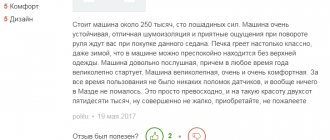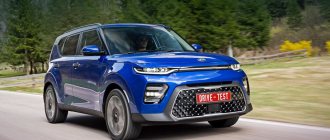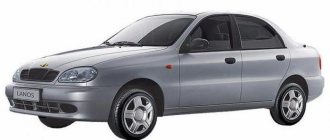Let's get to know each other better
The Mazda CX-7 passenger car belongs to the SUV class; it was first announced in January 2006, and on February 20 the start of sales of the mid-size crossover in Japan was announced.
The prototype of the new SUV was the MX-Crossport concept car. In appearance, the model is similar to the CX-9, but the platforms are different.
The Japanese car borrowed many components and parts from other brands, in particular, the 2.3 liter engine and 4x4 transmission from the Mazda 6 MPS, the rear and front suspension, respectively, from the Mazda Troika and MPV.
Before restyling, the car was produced in an all-wheel drive version; only one type of engine was installed on the car (MZR with turbocharging).
In the modernized version after 2009, the fog lights, radiator grille, bumpers were slightly changed, chrome trim was added to the front part and on the door sills, and the rear spoiler on the trunk door increased in size.
Mazda CX-7 (2006-2012)
The Mazda CX-7 in 2006 was a revelation—there were serious queues for the new cars. Why isn't the CX-7 in the same high demand on the secondary market?
And after ten years, Mazda is still a beauty! But the paintwork and body finishing are delicate: the external “chrome” decor gives way under the onslaught of road chemicals after three to five years, and the rolling at the bottom of the doors can cause corrosion in the most seasoned examples.
And it doesn’t hurt to look closely into the headlight eyes when meeting someone. Traces of moisture inside the head optics with xenon lamps are a bad sign: because of this, the headlights were often even replaced under warranty (a new original one costs $1000, and an analogue one costs 350-450). After all, if a lot of condensation accumulates, it can damage the ignition unit under the headlight ($300).
There were also replacements for the cute “snowflake” taillights ($350 for originals or $100-150 for copies). The engineers played a trick either with the type of plastic or with heat dissipation, but during long-term operation, especially on pre-restyling “Sevens” older than 2009, the body in its central part cannot withstand the heat from incandescent lamps and can not only melt, but also burn through — the owners came up with the idea to combat this scourge by installing “cold” diode lamps instead of conventional ones.
A bumper that protrudes from the sides is not necessarily the result of an accident: its fastenings are not durable. Headlight covers become cloudy over time, both outside and inside.
Electronics in general are unpretentious. Except that the CD changer sometimes goes on strike (dealers replaced the whole “head” at a cost of $600), and occasionally the standard alarm system kicks up. Does your air conditioner stop cooling? Most likely, the air conditioning compressor clutch ($140) has failed. And after 100-120 thousand kilometers, a worn bearing can lead to the shaft jamming, and you will have to shell out $380 for a new compressor or $200 for a rebuilt one.
Interior creaking on bumps is not uncommon in older Mazdas. Most often the front panel, door trim and seats are salted.
For turbocharged cars older than spring 2007, the high-pressure fuel pump may fail ($500). And if a more recent Mazda begins to twitch when accelerating and increases the already immodest fuel consumption to the point of indecentness, the fault of the front, located before the converter, sensor of oxygen concentration in the exhaust gases is to blame ($300 for the original and an order of magnitude (!) less for the analogue ). The piquancy of the situation is that replacing the sensor often does not help for a long time, especially on cars younger than 2008, when the lambda probe itself became more reliable. So you will have to remember not where you could grab surrogate fuel, but... how long ago the brake pads were changed!
The upholstery of the steering wheel and the transmission lever knob begin to lose their presentation after three to four years.
The fact is that, due to the design features, fluid spilled from the brake system reservoir goes directly to the electrical wiring harness of the engine control system. No problem? But the brake fluid turned out to be aggressive towards the wire insulation material: over time, it damages it and causes a short circuit in the harness or connector of the oxygen sensor! And there were so many such cases that the problem was recognized as covered by warranty and both the wiring harnesses (at least $450) and the sensor itself were replaced without any questions asked.
In cars of the first year of production, jerking when accelerating from low speeds also occurred for another reason: due to a crude engine control program. And the signal about a motor malfunction in models older than 2008 could be turned on due to the fault of the “ecological” valve of the intake manifold VSC (Variable Swirl Control): in cold weather, the vacuum drive of its damper was not always strong enough. Then they began to use a modified, more powerful drive.
The chairs are pleased with the durable leather on the front side - and are disappointed with the fragile substitute on the sides and rear. Corrosion should first be looked for in places near the folds at the bottom of the door panels
But what gives owners the most vivid impressions is the 2.3 turbo engine itself with the long brand name MZR DISI Turbo (Mazda Responsive Direct Injection Spark Ignition) - and, alas, not only because the CX-7 shares it with the “lighters” Mazda 3 MPS and Mazda 6 MPS. By the way, if on a crossover for the European market it remained in its pure form, with a power of 260 hp. and 98-octane gasoline, then for us and America it is derated to 238 and 244 hp, respectively. and tuned to 95.
For the 2.3 engine, from frequent short trips or long periods of idling, a malfunction signal may turn on due to the appearance of heavy carbon deposits on the spark plugs. The 2.5 engine on 2008 Mazda 6 cars has spoiled its reputation with unreliable piston pin locking rings. But on the CX-7 his biography is clear
The adventures began with the fact that not every BorgWarner K04 turbocharger ($1,800 for a new unit or 800 for a refurbished one) survived to 30-40 thousand kilometers, and the one that reached 120-150 thousand was considered incredibly lucky! It is difficult not to notice the beginning of problems: the CX-7 begins to smoke like a steam locomotive, especially after prolonged idling. In a special risk group are cars older than mid-2008 with an unsuccessful design of the supercharging unit cartridge (after it was modified). But everyone has the risk of coking the oil supply pipe - therefore, it is highly advisable to install a turbo timer on the CX-7, and change the oil at least once every seven to eight thousand kilometers.
2.2-liter turbodiesel - with a DPF filter, piezoelectric injectors and a low compression ratio (16.3:1) Any of the automatic transmissions, thanks to fresh oil, has not caused problems for years
And there should also be enough oil: the 2.3 engine is no different in modest oil appetite even in the naturally aspirated version of its younger sister Mazda 6. What can we say about the turbo version, which will not choke during active driving and will consume 0.5-0.7 liters of oil per thousand . If you don’t keep track of the level, the consequences can be disastrous - even a torn connecting rod or a cracked crankshaft... And keep in mind that the MZR engine sometimes does not survive serious repairs: it happens that when tightening, the steel bolts of the head or main caps break the threads in the aluminum block.
The “living” hydraulic mount of the power unit must be without traces of leaks of working fluid and with a gap to the side member. A reservoir with brake fluid and many wires under it are a dangerous neighborhood
Fresh oil will also be a benefit for the chain ($70) in the gas distribution mechanism drive: it does not withstand dynamic overloads in a powerful engine very confidently, and if it is dissatisfied with the diet, it stretches after only 40-50 thousand kilometers.
The problem is aggravated by the fact that as a result of the chain reaction, the shock load on the not particularly powerful VVT system phase shifter coupling ($300) increases - it can become loose after just 60-80 thousand kilometers. The first barely noticeable bell - or rather, a crackling sound - appears in the initial few seconds after starting the engine. And I don’t recommend waiting for the following signs: first, the valve timing will noticeably float away (the “diesel engine” will tell you about this) and the chain will stretch even more, starting to rattle against the cylinder head cover. If you stubbornly ignore this, then in an unfortunate combination of circumstances the gear may collapse, pieces of it may fall under the chain, and the sad ending will be the meeting of the valves with the pistons. The funny thing about the situation is that at first the weak point of the coupling was the unhardened key; at the beginning of 2008 it was strengthened - then the gear itself began to break. And only in 2010 the knot was finally brought to fruition.
Just don’t be alarmed by the clanging sound from under the hood on bumps after 80-90 thousand kilometers: its cause will definitely lie in the right engine hydraulic mount ($100 for the original and 50-70 for analogues). Moreover, it can misbehave not only due to leaks, but also due to excessive heating: the viscosity of the filler and, accordingly, the operating efficiency are reduced. The unit with a change in oil type was modified twice, in 2008 and 2014.
And remember that the “hot” 2.3 turbo engine itself is very afraid of overheating - be wary if the fan thrashes non-stop while driving and does not turn off for a long time after stopping the engine. The culprit may be not only a radiator clogged with dirt and dust ($200 for a branded one and half as much for “replacements”), which it is advisable to clean at least once every couple of years, but also a thermostat that sticks after 120-140 thousand kilometers ($35-40 both for the original and for analogues). It was modified only in 2011, replacing the valve material, and there was even a recall campaign regarding this.
An alternative to a capricious turbo engine? The 2.2 diesel engine of our own design, offered in Europe, which debuted on the second generation Mazda 6, cannot be found in our country during the day. However, in 2009, Mazda engineers decided to exchange the perky character of the CX-7 for reliability by implanting an aspirated 2.5 L5 series. This engine, which appeared in 2007 (also on the Mazda 6), is another version of the same naturally aspirated 2.3 “four,” but with a larger cylinder diameter and piston stroke, a modified intake system and gas distribution mechanism. And - a minimum of problems! The timing chain lasts for at least 200 thousand kilometers, and before that, concerns most often come down to adjusting the valves (usually after 120 thousand kilometers) and periodically cleaning the throttle valve.
It’s also not disappointing that in addition to the 2.5 engine there is a five-speed automatic transmission FS5A-EL, created in 2004 based on the four-speed FN4A-EL with Ford roots. At first, she suffered from inherited ailments: wear and tear after 100-150 thousand kilometers of the aluminum rear cover, in the molded caliper of which play appeared, and the third and fourth gear clutches. But the CX-7 received this unit already in a repaired state, and with normal treatment it is quite capable of serving 250 thousand kilometers, or even more.
And the six-speed automatic transmission paired with the 2.3 engine does not make us regret that five- and six-speed manual transmissions were officially unavailable to us. Firstly, because the AW6AX-EL gearbox, also known as the popular Aisin Warner TF-81SC, which appeared in the early 2000s and is familiar to owners of Volvo, Ford, Opel, Fiat, Saab, Peugeot and Renault cars, is also quite capable of last at least a quarter of a million kilometers. The only unfavorable point in her biography on the CX-7 is her dislike of frost: at temperatures below –30°C, due to thickened oil, slipping of the clutches could occur, and in an unfortunate combination of circumstances, the supply hose could break. In 2011, the thermal valve was modified (the spring pretension was changed) in the working fluid cooling system, and the problem was forgotten.
And secondly, there are questions about a manual six-speed gearbox paired with a powerful 2.3: with an active driving style, synchronizers (especially third gear) often wear out before 100 thousand kilometers. A five-speed manual transmission with a quieter 2.5 engine, by the way, does not raise any questions.
Restyling in 2009 brought not only changes in appearance, but also an alternative to the 2.3 turbo engine
Coincidence or accident, but in the same way at first they missed the frost resistance of the power steering system: excessive pressure of the viscous fluid tore off the hoses! The issue was resolved in 2010 by shortening the pipeline and using more reliable clamps.
The banner of “wet work” is taken up by the seals of the transfer case and rear gearbox, in which a runny nose occurs after 80-90 thousand kilometers in any weather. And in addition, after six to eight years, the transfer case may also develop a leak from its crankcase - due to the aging of the sealant between its halves!
However, the transfer case itself has enviable durability and breaks down extremely rarely, and there are no other issues with the all-wheel drive system. But if the owners of front-wheel drive cars (those with a 2.5 engine), as a rule, do not remember about the rear wheel bearings, then in all-wheel drive cars with a 2.3 they can hum after a mileage of about 60-80 thousand kilometers (250 dollars each, including the original hub and 100 “substitutes”)
The suspension is strong. Inexpensive front stabilizer bushings can irritate with squeaks after 20-30 thousand kilometers, but they do not lose their performance. Front shock absorbers (70-80 dollars for both original ones and analogues from famous companies) rarely get tired before 70-80 thousand kilometers, and out of solidarity with them, their supports are also retired at the same time (30 dollars each). But most of the other elements of both the front and rear suspension, and the steering, confidently cross the line of 100-140 thousand kilometers, and then most often the ball joints give up (you have to buy front control arms assemblies for 400 euros each).
The front brakes turned out to be weak: the discs ($260 for originals and $80–150 for high-quality “replacements”), especially on pre-restyling models, sometimes required replacement after some 15–20 thousand kilometers! And mainly due to runout, not wear. Dealers changed the discs under warranty, the owners tried to adapt larger parts from the older sister CX-9... As a result, the material of the discs and pads was changed, the protective covers were modified for better heat dissipation - the problem was overcome only in cars younger than 2009.
It turns out that the “seven” with a 2.3 turbo engine is not the best choice. But the prices are tempting! The difference even with the more compact Honda CR-V can be measured in six figures! If you are tempted, you should look for the relatively rare (5% of cars) Mazda CX-7 with a 2.5 engine: at five years of age, this will cost the same as the turbo version, 750-850 thousand rubles. Alas, it is less bright in character and only front-wheel drive - but there are no worries about the fate of turbines and chains.
The lineup
The range of power units was replenished with a 2.5 liter naturally aspirated internal combustion engine; in addition to the six-speed automatic transmission, a six-speed manual and automatic transmission 5 began to be offered, and front-wheel drive versions were added.
Direct competitors of the Mazda CX-7 are the Honda CRV and Toyota RAV4. In Russia, the crossover was in considerable demand immediately after its appearance, but over time its popularity has fallen somewhat.
The main reason for the drop in liquidity of this brand is the many shortcomings of the automaker, mainly car owners were upset by problems with the engine.
In 2012, production of the “Seven” was discontinued, replaced by the CX-5 with improved engines and a more spacious interior.
Although the model is no longer produced, it is of interest to potential buyers on the secondary market, and this car cannot be called uninteresting.
Options and prices
The Mazda CX-7 comes to the Russian secondary market at different prices with two basic configurations:
- 1) Touring
- 2)
The standard option is provided with the following set of equipment:
- ¨ anti-lock ABS;
- ¨ emergency brake booster EBA;
- ¨ 6 airbags;
- climate control;
- air conditioner;
- ¨ LED optics;
- ¨ electric windows;
- ¨ 18-inch wheels;
- ¨ radio and much more.
The more advanced version adds a number of additional options: leather trim, xenon headlights, keyless entry and cool audio equipment.
Now let's move on to the question: how much does the Mazda CX-7 cost in Russia? We answer: the price for a first generation sample does not exceed half a million rubles. The cost depends entirely on the years the car has lived through, its condition, tuning, frequency of replacement of components, and mileage. Later versions, even used ones, can be purchased for 600-700 thousand, sometimes a little more.
Exterior and interior
Although the CX-Seventh is an old-timer on the automobile market, it has not lost its visual appeal - “muscular” wheel arches, smoothed shapes and a rear fairing give the car a sporty look, and chrome door handles add charm to the design.
Regardless of the modification, the crossover is equipped with very nice alloy wheels with an original design, and turn signal indicators are built into the side mirrors.
For ease of use of the car, keyless entry is provided; to unlock the doors, just press the button located next to the lock of the outside door handle on the driver's side.
The front seats in the cabin with lateral support look good, but are still somewhat harsh.
The three-spoke multifunctional steering wheel is small, covered in leather, and the steering is equipped with power steering.
The steering column is adjustable only in height; a convenient foot-operated parking brake is located on the left side of the pedal assembly.
Despite the fact that the Mazda CX-7 is considered one of the largest in the mid-size crossover segment (length 4.7 m), the interior can hardly be called very spacious, since there is not too much knee room for rear passengers.
But among the advantages of the SUV interior it should be noted:
- fairly high-quality finishing materials;
- good ergonomics;
- due to the high seating position, good visibility;
- high-quality audio system sound;
- information content of the instrument panel.
The trunk volume is 455 liters; with the rear seat backs folded down, it increases to 774 liters.
Since the luggage compartment floor is located quite high, and the rear body pillars are at an acute angle, it is problematic to place large cargo here.
A small spare tire is placed under the floor, and the luggage being transported on top can be covered with a retractable shelf.
Interior
The same style can be seen in the interior. During assembly, attention is paid not to the luxury of the interior, but to the quality of individual parts. The high seating position increases the driver's visibility while driving. In the production process of the Mazda CX-7 interior, only advanced technologies were used.
The steering wheel for this model was transferred from the third Mazda. The individual instruments on the panel look very nice and are properly informative. However, many may get the impression that the center console is overloaded with various keys and buttons, which is especially noticeable against the backdrop of two small screens.
Owners of the Mazda CX-7 note the comfort in controlling the options and functions of the car. All sorts of “twists” are located very conveniently and close to the driver’s hands. The steering wheel in this SUV is adjustable for reach and tilt. Electric adjustment is also present in the rear-view mirrors. The position of the seats in the car can be adjusted by pressing buttons.
Finding the optimal position is not so easy, because the seats, which received a sporty profile, are installed low and deep in the cabin, and the A-pillar is heavily tilted back. Due to this, the quality of visibility from the driver's seat is not ideal. The three-spoke steering wheel itself, along with the gearshift lever, was covered in leather.
Leather steering wheel
The steering wheel contains control elements for important electrical systems of the vehicle. The panel installed in front seems to be divided into two functional zones, where the lower one has an instrument panel and round-shaped ventilation dampers, and the upper one has an on-board computer screen. The front seats are separated by a high central tunnel. They are equipped with belts with tension limiters.
The stove was installed so that even in winter, the interior temperature could rise within a few minutes after switching on. When a powerful audio system is installed, it is possible to obtain such a strong sound that its vibrations can rattle the door trim. Many people note the inconvenience of the location of the screen on which the image from the rear view camera is displayed.
However, very often in rainy weather it becomes clogged, and the image is very poor. As a result, certain kinds of difficulties arise when driving in reverse. The second row of seats can comfortably accommodate two people. But the third one will have to make room. The trunk has a capacity of 455 liters with a fairly high loading capacity.
If you fold the back row of seats, the capacity increases significantly. Transporting large household appliances or small pieces of furniture will become much easier! As you know, the Japanese pay special attention to the quality of finishing and materials. This is especially felt in the Mazda CX-7!
In 2007, the Mazda CX 7 won the special prize “Best SUV” in Japan.
When decorating the interior of the Mazda CX-7, hard plastic was used, however, it is not creaky. To have somewhere to put your things, the Japanese designers provided a 5.4-liter glove compartment placed between the front seats. In addition, based on the Mazda CX 7 photo, there is a glove box that can be locked with a key, as well as pockets in the front doors and magazine wells on the aft side of the front seats.
With the rear row of seats folded, the useful volume increases to 1,350 liters of usable space. Already following 2009, the vehicle received a modernized dashboard, a 4.1-inch LCD screen, Bluetooth support and a driver’s seat with a 3-position memory function. The restyled model already has a multimedia system that supports touch input.
Technical characteristics of Mazda CX-7
The main engine that the car is equipped with is a 2.3 L turbocharged petrol engine with an in-line arrangement of four cylinders and a capacity of 238 horsepower.
This engine, paired with automatic transmission-6, allows you to reach 100 km/h in 8.3 seconds and move at a maximum speed of 181 km/h.
The manufacturer declared fuel consumption of 15.3 liters per 100 km in the city and 9.3 liters on the highway, but in practice fuel consumption is even higher. The 2.5 L Mazda CX-7 engine is also a four-cylinder in-line, with a power of 163 hp. With.
Acceleration time to “hundreds” with this internal combustion engine is 10.3 s, maximum speed is 173 km/h.
There is also a diesel version (2.2 L, turbocharged, 173 hp), but in Russia there are practically no cars with diesel engines.
The cars are equipped with a 62 liter fuel tank, the recommended gasoline is AI-95.
For Russian users, cars with automatic 5-speed or 6-speed transmission are available. Transmission, manual gearbox is installed only on diesel crossovers.
With a wheelbase of 275 cm, the turning circle of the car is 11.4 m, the car itself is quite heavy, depending on the type of units installed, its weight ranges from 2100 to 2270 kg.
The increased ground clearance of 20.8 cm provides good cross-country ability; on all-wheel drive vehicles, the rear axle is connected automatically, and by default the front wheels are driven.
The front suspension of the Mazda CX-7 is a standard McPherson type, the rear is a “multi-link”.
The rear axle looks like this.
All wheels are equipped with disc brakes, the diameter of the rims in the basic configuration is R17 or R18, the size of factory tires is 215/70.
Options
On the Russian market, the CX-seventh is found in two equipment options - Touring and Sport.
The basic model comes with:
- six airbags;
- ABS, ESP, ASR, EBD systems;
- electric windows;
- cruise control;
- immobilizer;
- MP3/CD audio system with four speakers;
- trip computer;
- climate control;
- electric mirrors;
- central locking
For an additional fee, an additional package of options is purchased, which includes a rear view camera, a CD changer, a rain sensor, and tinted windows are installed on the car.
In the Sport package, the above options from the package are present as standard; the audio system is equipped with 8 speakers and a subwoofer.
All seats have leather upholstery, xenon and fog lights are provided, and the engine starts with a button.
Additional options here are a power sunroof embedded in the roof, electrically folding side mirrors, and a lane change assistant.
Exterior
At the front, the Mazda CX-7 received pronounced lines of the Mazda family. A powerful air intake is located at the bottom, and a radiator grille with clear raised lines is installed in the upper part, which emphasizes the power of the front wings and the side of the hood. The optimized shape of the front bumper provides the car with excellent aerodynamics. The front and rear fog lights look original, and very usefully, the car was equipped with mudguards and headlight washers.
Mazda CX-7
When looking at this car from the side, the first thing that stands out is the A-pillar, as the angle of the roof is 66 degrees, and the windshield has a deeper angle than other sports cars. Thus, the curved roof flows smoothly into the B-pillar and then changes direction, descending to the C-pillar.
The protruding wheel arches attract a lot of attention; this car is equipped with 18-inch wheels, 235/60 R18 tires and alloy wheels - all this further adds aggression to the appearance of this sporty beauty. At the rear of the body, like all sports cars, a pair of large exhaust pipes were installed, lights with round inserts extend onto the sidewall, and where would we be without a rear spoiler?
At the rear of the body, like all sports cars, a pair of large exhaust pipes were installed, lights with round inserts extend onto the sidewall, and where would we be without a rear spoiler?
Mazda CX-7 - rear view











